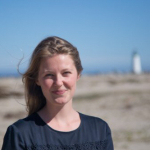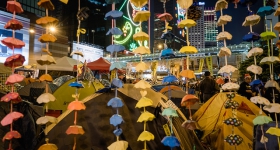On March 1, 1954, John Anjain was awakened by a deafening boom. When he ran outside of his house to investigate, he was greeted by a kaleidoscope sky: brilliant colors filled the heavens. It was early morning on Rongelap Atoll, a ring of islands in the vast sea between Hawai’i and Guam. The largest nuclear weapon that had ever been tested by the U.S. military was now raining radioactive powder down on his island. Children played in the snow-like fallout that coated every grain of sand, seeped into the soils of the taro patches, entered people’s homes, and stripped the skin and hair from their bodies.
John, like many who witnessed the explosion, has passed away. But before he did, he shared his story with his niece, Neisen Laukon, who was an infant at the time. “It was white everywhere,” she tells me.
Two representatives of the U.S. military arrived the next day to inspect the island; they fled after mere minutes, terrified for their own lives at the sight of so much radioactive waste. Two days later, military personnel came to evacuate the few hundred people whose ancestors had made Rongelap their home for thousands of years. There was no way Neisen could have known then that her people would be saying goodbye to their homeland forever.
From 1946-1958, the U.S. tested sixty-seven nuclear weapons in the Marshall Islands, each a thousand times more powerful than the bomb dropped on Hiroshima. At the time, the Marshall Islands were under U.S. control as part of the Trust Territory of the Pacific Islands. The peoples of Bikini and Enewetak Atolls were asked by the U.S. military to sacrifice their homelands “for the good of mankind”. Their islands were used as ground zero for the weapons tests. The damage was supposed to be limited to those atolls, but Castle Bravo produced a cloud of radioactive fallout that poisoned dozens of other islands, forcing people like Neisen to evacuate.
Sixty-four years after the Castle Bravo explosion, I meet Neisen in Springdale, Arkansas, in a small, fluorescently-lit room at the Center for Nonprofits. Springdale is home to thousands of Marshallese today and to my own, non-Marshallese family. Neisen was in the first wave of Marshallese to move to this northwest corner of the Deep South, attracted by the promise of higher education and a better, safer future.
Neisen was a small child when Castle Bravo made refugees of her people. Most of what she remembers was told to her by family members like Uncle John. But Neisen says people didn’t like to talk about the years immediately following the evacuation. She and her people were housed on Kwajalein Atoll, where the U.S. still maintains a military base in the Marshall Islands. There, they were subject to humiliating conditions.
Neisen was told about these years by her grandmothers. I can see the pain behind her eyes when she tells me, “They took them like animals, women and men and kids together. They had to take all their clothes off… They had to burn their clothes and then they sprayed them down, like animals. They gave the women men's T-shirts to wear. [They were just wearing] their underwear. They had burned bodies.”
According to her grandmothers, the Americans took them to the oceanside of the island every day, twice a day, for three months. There, Marshallese interpreters were tasked with instructing them to disrobe, wash with soap, and subject themselves to a radiation detector. Neisen explains that the interpreters were members of the close-knit Rongelap community. “[The interpreters were] their brothers, could be a nephew or a grandson seeing his sister and mother and grandmother naked,” her grandmothers told her.
The people of Rongelap didn’t know they had been enrolled in a classified government study on the effects of exposure to nuclear fallout on human health, known as Project 4.1. They never gave consent to participate and were never informed of the results.
Three years later, in 1957, the U.S. told the people of Rongelap it was safe to return home. Neisen recalls the hardships growing-up on a radioactive island and the confusion many felt as unwitting subjects of a military experiment. “They came every January to check on us. They called themselves AC. I don't know what AC stand for,” she says. She is remembering the U.S. Atomic Energy Commission, which was absorbed into the Department of Energy in 1977. “But that's what I knew then. They were doctors, you know, they came and checked us, but they didn't ever tell us what was wrong with us. They took blood and everything, check you, and then left,” she says with a baffled expression.
According to Neisen, they faced near-starvation when food rations ran out because they knew the native foods to be poisonous, though they were never told how radiation works. As a last resort, they would eat what the islands produced and suffer the consequences.
Neisen recalls, “They brought us food that they called C-rations. Soldiers' food. And when we ran out, we’d have to eat anything, whatever we could find.” She remembers getting blisters in her mouth from the local foods, but she didn't understand why. She placed her faith in the knowledge and integrity of the U.S. Atomic Energy Commission personnel. She says, “You thought everything was okay, you know? Because they [the Americans] said, ‘Everything, there's nothing wrong, it's okay.’”
Of course, everything wasn’t “okay”: for the next three decades, babies born on Rongelap were born stillborn or with severe birth defects. Children died of leukemia. Cancers became commonplace. Neisen’s father, the iroijlaplap or head chief, pained and angered by the sicknesses plaguing his people, sought external help. In 1985, Greenpeace was enlisted to relocate the whole population – about 350 people – 100 miles away to Mejato Island. Many moved yet again, to Ebeye Island, where they and their descendants remain today. Neisen, meanwhile, was building a life in the U.S.
***
Neisen left Rongelap for the last time at age 12 and moved to the U.S. when she was 19 with her husband and their son, who they adopted after his mother became too ill with radiation poisoning to care for him.
The Marshall Islands have an agreement with the U.S. known as a the Compact of Free Association, which – among other provisions – allows Marshallese to travel to the U.S. without a visa and remain indefinitely as “nonimmigrant residents”. In return, the U.S. maintains military control over their islands and provides substantial financial assistance.
As a result, thousands of Marshallese have migrated to the U.S., many to Springdale, Arkansas – in fact, so many that it’s fondly known among Marshallese as “Springdale Atoll”, an extension of their island home. The traditions of the islands are very much alive in Springdale, with kemem – important first birthday celebrations – happening almost every weekend, a Marshallese radio station playing island tunes at all hours, multiple Marshallese churches decorated in intricate palm leaf handicrafts, and NGOs specializing in working with Marshallese families. Neisen’s daughter, Faith, who was born in the U.S. and is now in her early forties, tells me in her slight Southern accent, “It's kind of like you're living in the Marshall Islands, just in a different climate.”
But it was not just a different climate. It was also different responsibilities. Neisen and her husband struggled to stay afloat their first years in the U.S.
“When we first came we didn't have no clue how to do a lot of things,” says Neisen. “You got monthly bills over here, like water, electricity, house, cars, insurance, all that stuff. Back home, you don't have those things… We didn't have money when we first came.” She explains, “That's why we named [our first daughter] Faith. We didn't have insurance. And we were going to school, my husband was cleaning and stuff like that and I was working at the cafeteria. So I named her Faith because I said, ‘We don't have nothing, but God provide for us.’”
Eventually, she found work at the Kraft Foods factory, packaging the macaroni and cheese, and had six more children.
But through all Neisen’s triumphs, the legacy of Castle Bravo is inescapable. At 57, she was forced to retire from her job at the Kraft Foods factory when her illness made it impossible for her to continue. She misses work, but finding a job she can sustain with her medical complications is challenging.
“It's really boring not working,” says Neisen. “Working for 20 years it's like, I was working and taking care of kids and all that. I was busy all the time. But now, I don't do nothing. Cooking in the morning and cleaning and then what? What am I going to do today, go to sleep? There were some jobs over here [in Springdale] to translate for the school and stuff like that. I wanted to do that, but I was blind [likely due to radiation exposure]. This eye,” she says, gesturing to her clear brown eye, “I just got it fixed two months ago. I'm going back next week to get [the other] one fixed. I turned 65 so I can use my Medicare.”
The U.S. did create a fund for health care costs for those exposed to Castle Bravo, but it has proven to be grossly inadequate. Many Marshallese-Americans like Neisen rely on programs like Medicare and Medicaid, but it isn’t always easy for Marshallese to access these resources. Some federal programs extend to Marshallese residents but not all, and laws vary by state. It doesn’t help that many American medical professionals are unaware of our country’s violent history in the islands.
When Neisen’s lymph nodes became infected, she insisted her doctors check her radiation levels, but she still isn’t sure they ever did. “There were forty doctors that worked on me, studied my sickness and all that. I told all of them about the bomb. But, you know, they didn't tell me anything, so I don't know if they didn’t believe me or what. Seemed like some of them didn't really know what happened there [on Rongelap].”
The reality is: most Americans don’t “know what happened there”. Most Americans don’t know that Rongelap, Bikini, Enewetak, and Utirik Atolls are still irradiated. Most Americans don’t know that a dome of radioactive waste is leaking into the waters of Enewetak Atoll. Most Americans don’t know that we have never paid the $2 billion owed to survivors of nuclear weapons testing in the Marshall Islands. And as long as most Americans don’t know, the U.S. will never be held accountable.
***
Neisen, like many nuclear refugees, wants to go home. “I like it here,” she says, “but I’d like to go back home. I’d like to go back home and die there.”
Neisen’s story is one of thousands. The peoples of Rongelap and Bikini Atolls are still living in exile today. The peoples of Utirik and Enewetak Atolls live in fear on islands they know are slowly poisoning them. Dozens of other islands were contaminated but never acknowledged by the U.S. government, meaning those peoples have no claim to the limited funds available to nuclear survivors. Unless immediate action is taken to clean-up Rongelap and the other atolls contaminated with nuclear waste, Neisen’s dream of a homecoming – her right to a homecoming – will never be realized.
After sitting with me for over an hour, Neisen thanks me, graciously, and asks, “What else do you want to know?”
There’s so much more I want to know. But my questions aren’t for her.
--
This interview was conceived and conducted in collaboration with my research partner, Autumn Bordner.










Comments